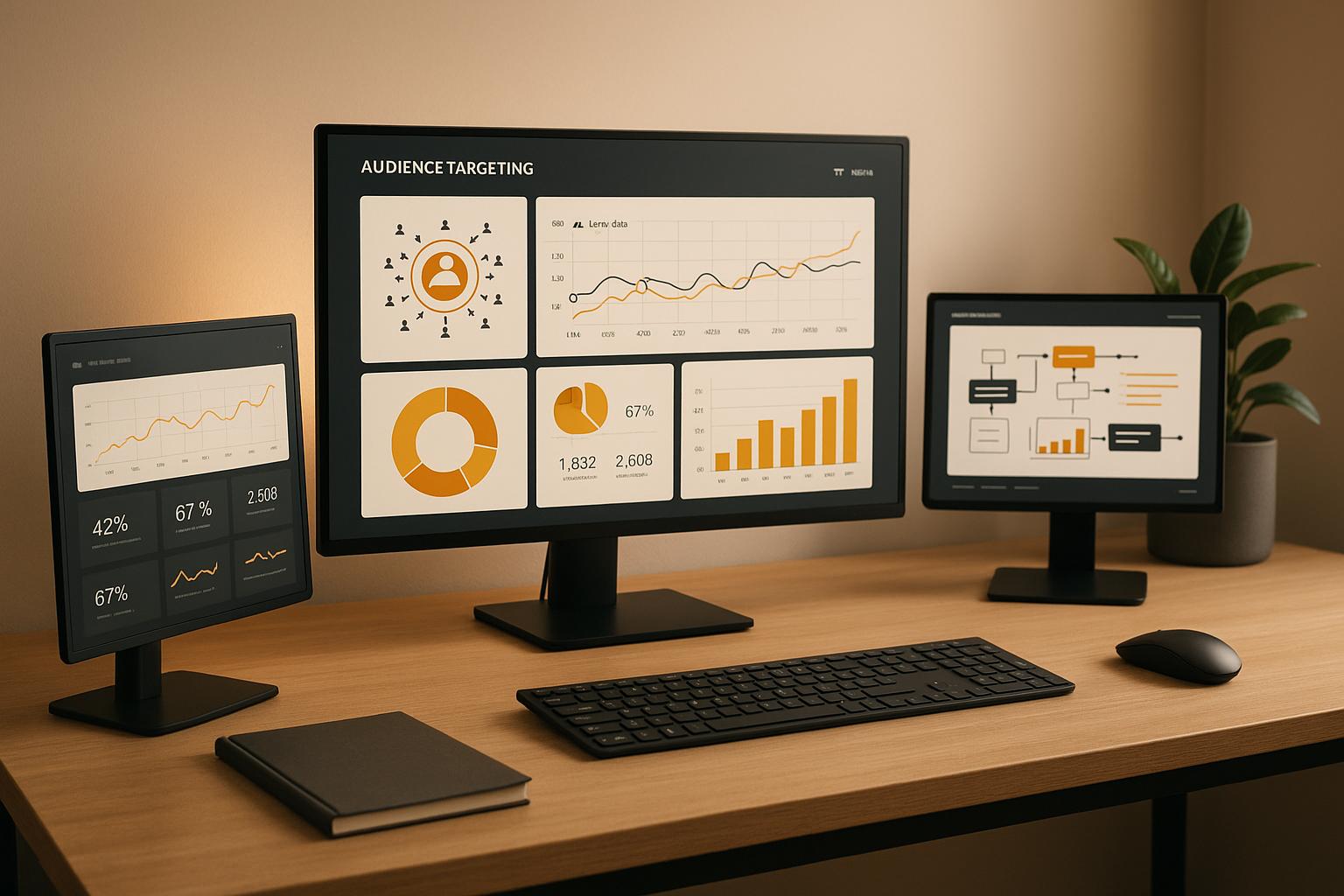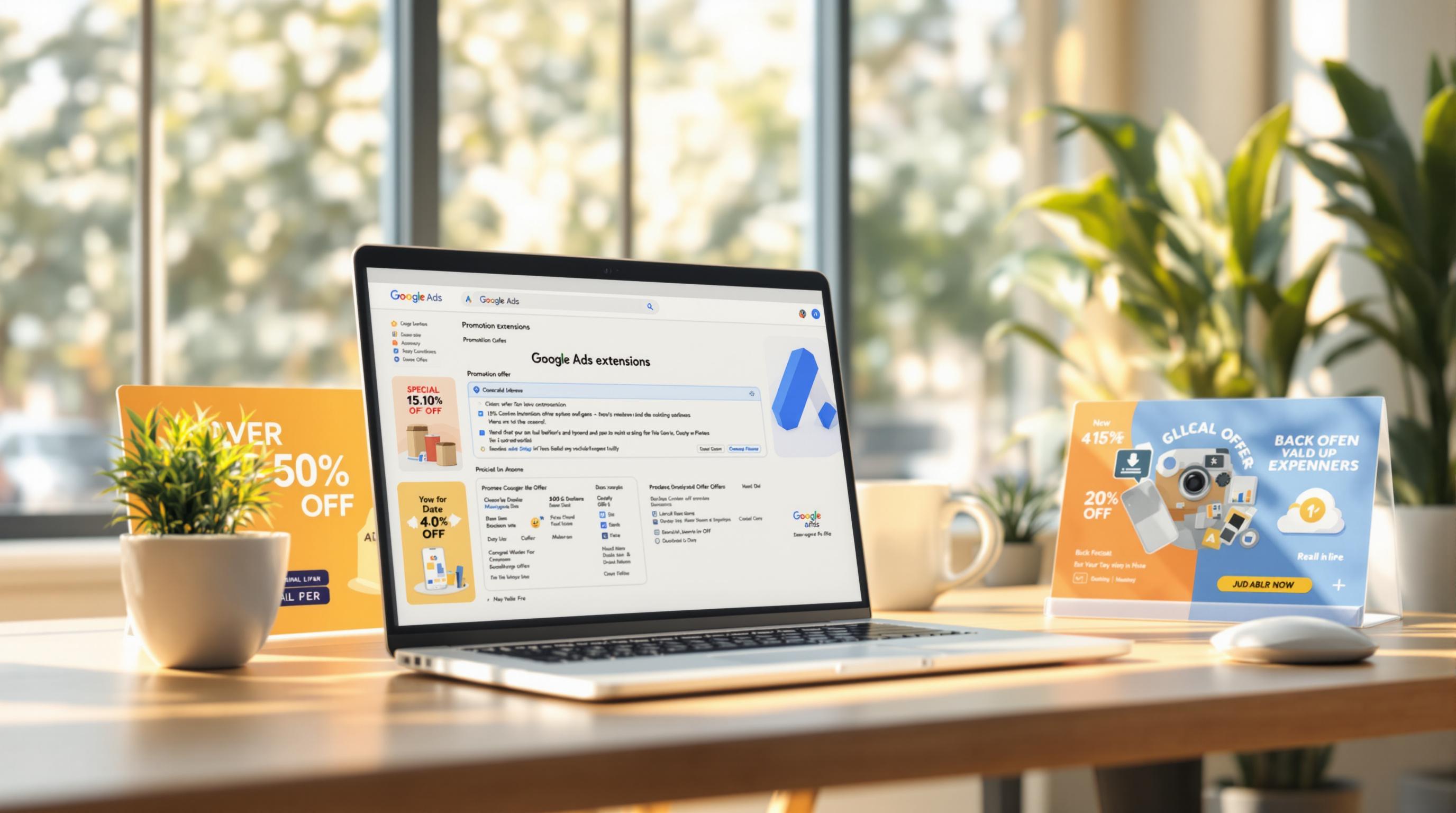Testing your PPC ad creatives can save money and improve campaign results. A structured approach ensures your ads perform better, connect with your audience, and beat competitors. Here's how to do it:
- Set Goals: Define what success looks like (e.g., higher CTR, lower CPA).
- Create Variations: Test one element at a time (headlines, visuals, CTAs).
- Build a System: Use tools like Google Ads Experiments or Facebook DCTs.
- Track Results: Monitor metrics like CTR, CPA, and ROAS.
- Review and Update: Scale winning ads and fix underperforming ones.
Quick Overview of Key Metrics
| Metric | What It Measures | Why It Matters |
|---|---|---|
| Click-Through Rate (CTR) | Ad relevance and audience interest | Higher CTR = Better engagement |
| Cost Per Acquisition (CPA) | Cost to gain a customer | Lower CPA = Higher profitability |
| Return on Ad Spend (ROAS) | Revenue per ad dollar spent | Higher ROAS = Better efficiency |
By following these steps, you can optimize your PPC campaigns for better results and smarter spending.
PPC Ad Copy Testing Strategies
Step 1: Set Clear Testing Goals and Metrics
To make the most of your PPC ad testing, it’s crucial to define clear goals and metrics. This helps you avoid wasted efforts and ensures you can track measurable results.
Set Campaign Objectives
Your testing objectives should align with your overall business goals and focus on measurable outcomes that impact profitability. Some common objectives might include:
- Boosting click-through rate (CTR)
- Lowering cost per acquisition (CPA)
- Increasing conversion rate
Here’s a quick breakdown of how objectives can vary by campaign type:
| Campaign Type | Primary Objective | Secondary Objective |
|---|---|---|
| Brand Awareness | Impression Share | Click-Through Rate |
| Lead Generation | Conversion Rate | Cost Per Lead |
| E-commerce | Return on Ad Spend | Average Order Value |
| App Downloads | Install Rate | Cost Per Install |
Once you’ve nailed down your objectives, choose metrics that directly reflect these goals.
Pick Performance Metrics
Metrics are your compass for measuring success. Use a combination of primary, secondary, and diagnostic metrics to get a complete picture. Here’s how they break down:
- Primary metrics: These are the core indicators of success, like conversion rate, ROAS (Return on Ad Spend), or CPA.
- Secondary metrics: These provide supporting insights, such as bounce rate or time on site.
- Diagnostic metrics: These help you dig deeper into performance drivers, including impression share and quality score.
The tools in the Top PPC Marketing Directory can help you track these metrics effectively.
Write Your Test Hypothesis
A well-crafted test hypothesis serves as the foundation for your PPC experiments. It should clearly define:
- Change: Specify the element you’re testing (e.g., ad copy, landing page design).
- Expected Outcome: Identify the metric you aim to improve.
- Target Improvement: Set a measurable goal, like a 10% increase in CTR.
- Reasoning: Explain why you believe this change will deliver results.
For established campaigns, aim for modest improvements of 5–15%. If you’re testing new campaigns, you can target more ambitious gains of 20% or higher.
Step 2: Create Ad Variations
Once your testing goals are set, it's time to craft ad variations that focus on specific creative elements.
Test One Element at a Time
To get clear insights, only change one element per test. This way, you can pinpoint exactly what’s driving performance changes. Some key elements to experiment with include:
- Headlines: Try different angles or value propositions.
- Visuals: Test images or videos that resonate with your audience.
- Call-to-Action (CTA) Buttons: Compare direct CTAs like "Buy Now" with softer ones like "Learn More."
- Ad Copy: Highlight various benefits or features.
- Display URLs: Experiment with different URL structures or messaging.
Once you know what you want to test, it’s time to organize your creative assets.
Build Your Asset Collection
Gather your creative elements into easy-to-navigate categories:
- Headlines: Include variations that showcase different selling points.
- Visual Assets: Compile a mix of images and videos.
- CTA Buttons: Create a range of options, from assertive to subtle.
- Body Copy: Develop multiple versions that emphasize unique benefits or features.
Dynamic creative testing can streamline the process by automatically combining assets and identifying what works best - saving you time and budget. With your creative library ready, the next step is choosing a testing method.
Pick Your Testing Method
The right testing method depends on your campaign's scale and goals:
- A/B Testing: Perfect if you want to test one element at a time. It’s straightforward and works well for campaigns with smaller budgets or limited traffic.
- Multivariate Testing: Better suited for campaigns with higher traffic, allowing you to test multiple elements simultaneously for deeper insights.
To simplify the process, consider using tools from the Top PPC Marketing Directory. These platforms can automate testing, rotate assets, and provide detailed analytics, making it easier to fine-tune your campaign based on real data.
Step 3: Build Your Testing System
Creating a reliable testing system is key to understanding what works in your campaigns and why.
Select Test Timing
When it comes to timing your tests, the schedule you choose can significantly affect your campaign's results. There are two main approaches:
Sequential Testing
This method tests one variable at a time, making it easier to pinpoint what’s driving performance changes. It’s particularly useful when:
- You’re analyzing seasonal trends.
- Budgets are tight, and resources are limited.
- Big changes are being introduced to your campaign.
- You need to ensure complete isolation of variables.
Simultaneous Testing
This approach runs multiple variations at the same time, allowing for quicker insights. It’s a great choice for:
- Campaigns that are time-sensitive.
- Testing straightforward creative elements like headlines or images.
- Comparing results under identical market conditions.
- Collecting a large amount of data efficiently.
Choose the strategy that best aligns with the goals and constraints of your campaign.
Set Your Test Budget
Your budget needs to be large enough to produce meaningful results but small enough to avoid unnecessary overspending. For example, instead of running a single $25,000 daily campaign, you could break it into 10 smaller tests of $2,500 each. This staggered approach allows you to identify high-performing concepts before committing more resources to scale them.
Set Up Testing Software
To ensure you capture accurate results, set up your testing software properly. Most major advertising platforms already include tools to help with this:
Google Ads Experiments
- Assign at least 50% of your original campaign traffic to the test.
- Run the experiment for a minimum of 14 days.
- Turn on notifications for when statistical significance is achieved.
- Make sure conversion tracking is enabled.
Facebook Ads Manager
- Use Dynamic Creative Tests (DCTs) to test different combinations of creative assets.
- Pair creative elements to compare their performance.
- Set cost caps aligned with your target CPA.
- Enable automated monitoring to track performance.
For campaigns running across multiple platforms, consider using tools from the Top PPC Marketing Directory to simplify cross-platform testing and data collection.
sbb-itb-89b8f36
Step 4: Track and Verify Results
Now that your testing system is in place, it's time to focus on tracking and verifying results to ensure your campaigns are performing as expected.
Monitor Live Results
Keep an eye on real-time data to make adjustments as needed. Key metrics to track include:
- Click-through rate (CTR)
- Conversion rate
- Cost per click (CPC)
- Cost per acquisition (CPA)
- Return on ad spend (ROAS)
Pro tip: Set up custom alerts within your ad platform to notify you if performance metrics deviate significantly from your baseline. This allows you to react quickly to any issues.
"When one ad set performs exceptionally well (e.g., at a $25 CPA), it can attract most of the budget, limiting insight into the performance of creatives in other ad sets."
Once you're confident in the reliability of your data, start optimizing your ads immediately.
Verify Data Accuracy
Before making decisions, it's crucial to validate that your data is statistically reliable. Here are some recommended thresholds:
| Metric | Minimum Threshold |
|---|---|
| Impressions | 1,000 per variation |
| Clicks | 100 per variation |
| Test Duration | 14 days recommended |
| Statistical Confidence | 95% or higher |
To maintain accuracy:
- Use fresh audiences for each test round.
- Account for external factors like seasonal trends.
- Cross-check data across multiple platforms.
- Watch for anomalies, such as click fraud or sudden spikes.
Make Quick Fixes
As trends emerge, act swiftly to refine your approach.
For Underperforming Ads:
- Pause ads with high CPAs.
- Redirect budget toward better-performing ads.
- Adjust bids based on performance data.
For High-Performing Ads:
- Gradually increase the budget for top-performing ads.
- Develop variations of successful elements to test.
- Experiment with new audience segments to expand reach.
Leverage your testing tools to automate much of this process, saving time and ensuring consistency.
For instance, a retail brand running a holiday PPC campaign noticed one ad variation had a significantly higher CPA compared to others. By monitoring live results, they quickly paused the underperforming ad and allocated the budget to the top-performing creative. Within 48 hours, this adjustment led to a 20% improvement in overall campaign ROAS.
Step 5: Review and Update Ads
Review Test Data
Take a close look at your test results to identify which creatives are delivering the best performance. Compare key metrics across different variations to get a clearer picture:
| Metric | What It Tells You | Evaluation Criteria |
|---|---|---|
| Click-through Rate (CTR) | How relevant and appealing your ad is | Compare against your account's average CTR |
| Conversion Rate | How effective the ad is at driving desired actions | Measure against specific campaign goals |
| Cost per Acquisition (CPA) | The efficiency of your ROI | Ensure it's within your target range |
| Return on Ad Spend (ROAS) | The ad's profitability | Should meet or exceed your set benchmark |
For deeper insights, break down the data further by device, audience type, and ad placement. Once you’ve got a clear understanding of what works, shift your focus to scaling the most effective creatives.
Expand Successful Ads
After identifying the ads that perform best, it’s time to scale them up in a controlled manner:
- Increase budgets gradually: Start by raising the daily budget for your top-performing ads in small increments. Keep a close eye on performance for 48–72 hours before making additional changes.
- Replicate winning elements: Take what’s working and apply it to other campaigns. For example, if a particular call-to-action is driving great results, integrate it into similar ad groups to maximize its impact.
Fix Low-Performing Ads
Underperforming ads require immediate attention. Here’s how to address them:
- Pause ads with high CPAs and redirect the budget to your best-performing creatives.
- Update elements of the ad - like headlines, visuals, or calls-to-action - using insights from top-performing ads.
- Keep a record of what you’ve learned during testing for future campaigns.
- Create new variations that incorporate elements from successful ads.
- Experiment with fresh audience segments to see if performance improves.
For instance, one retailer tested multiple ad creatives and found that one variation delivered a 30% higher CTR and reduced CPA by 20%. By shifting more budget to this variation and tweaking its messaging for seasonal promotions, they achieved a 15% overall lift in campaign ROAS.
Tools from the Top PPC Marketing Directory can make this process easier, helping you analyze test data and implement changes efficiently. Make it a habit to review your ads monthly to catch creative fatigue early and keep your campaigns running at their best. Regular updates ensure your testing strategy stays effective and adaptable.
Conclusion: Main Points for Better Ad Testing
To sharpen your PPC ad strategy, it's essential to focus on a disciplined approach, clear goals, and smart testing techniques. A well-organized testing process ensures you're consistently identifying what works and scaling it effectively.
One effective approach includes methods like Before/After tests for sequential changes and Dynamic Creative Tests (DCTs) with cost caps to run simultaneous variations. These strategies help you pinpoint winning ad concepts quickly and efficiently.
A 2023 study by Kynship highlighted that using Campaign Budget Optimization (CBO) with cost caps can prevent ad sets from competing for budget, allowing for better resource allocation and improved efficiency.
Here’s a simple framework to guide your testing process:
| Testing Phase | Key Action | Success Metric |
|---|---|---|
| Planning | Develop clear hypotheses | Test goals aligned with business objectives |
| Execution | Test one variable at a time | Achieve statistical significance in results |
| Analysis | Use fresh audiences for tests | Gather unbiased performance data |
| Optimization | Replace underperforming ads | Drive continuous improvement |
| Scaling | Allocate budget to winners | Boost overall ROAS |
This framework helps ensure your campaigns stay on a path of steady improvement.
Keeping your testing cycles active and documenting results consistently can prevent creative fatigue and keep your campaigns evolving. Platforms listed in the Top PPC Marketing Directory can simplify this process, helping you stay organized while scaling your best-performing ads.
FAQs
What should I test first in my PPC ad creatives to achieve the best results?
To make the most of your PPC ad testing, concentrate on the factors that can significantly influence performance. Begin with testing your headlines and ad copy, as these are key drivers of click-through rates (CTR). If your campaign includes display or video ads, try experimenting with different visuals or ad formats to see what resonates best. Lastly, fine-tune your calls-to-action (CTAs) to identify which phrases lead to the highest conversion rates. Focus on testing one variable at a time to ensure your results are clear and provide actionable insights.
What’s the difference between A/B testing and multivariate testing, and how do I choose the right one for my PPC campaigns?
When it comes to improving your PPC ad performance, A/B testing and multivariate testing are two valuable methods, each with its own strengths. Here's how they differ:
- A/B testing is all about comparing two versions of an ad or landing page to determine which performs better. The key here is focusing on just one variable at a time, like testing a headline or call-to-action.
- Multivariate testing, on the other hand, takes a broader approach. It evaluates multiple variables at once to see how different combinations of elements - like images, headlines, and button colors - affect performance.
Choosing the right method depends on your goals and the amount of traffic you’re working with. If you're looking to test a single tweak, like a new headline, or if your traffic is on the lower side, A/B testing is a straightforward and effective choice. But if you’re handling a high-traffic campaign and want to understand how various elements interact, multivariate testing offers a more comprehensive approach.
A good rule of thumb? Start with A/B testing for simple changes, and move to multivariate testing when you’re ready to dive into more intricate experiments.
How can I ensure my PPC ad testing data is accurate and reliable for making better decisions?
To get accurate and reliable results from your PPC ad testing, start by defining specific goals - whether that's boosting click-through rates, increasing conversions, or something else measurable. Stick to consistent testing methods, like A/B testing, where you compare ad variations under the same conditions. Testing too many elements at once can muddy the results, so focus on one variable at a time.
Keep an eye on your data collection process to catch any errors, and allow enough time for your tests to run so you can account for natural fluctuations. Make it a habit to review key performance metrics regularly. This will help you spot patterns and fine-tune your campaigns based on the insights you gather.


